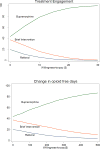Cost-effectiveness of emergency department-initiated treatment for opioid dependence
- PMID: 28815789
- PMCID: PMC5657503
- DOI: 10.1111/add.13900
Cost-effectiveness of emergency department-initiated treatment for opioid dependence
Abstract
Background and aims: In a recent randomized trial, patients with opioid dependence receiving brief intervention, emergency department (ED)-initiated buprenorphine and ongoing follow-up in primary care with buprenorphine (buprenorphine) were twice as likely to be engaged in addiction treatment compared with referral to community-based treatment (referral) or brief intervention and referral (brief intervention). Our aim was to evaluate the relative cost-effectiveness of these three methods of intervening on opioid dependence in the ED.
Design: Measured health-care use was converted to dollar values. We considered a health-care system perspective and constructed cost-effectiveness acceptability curves that indicate the probability each treatment is cost-effective under different thresholds of willingness-to-pay for outcomes studied.
Setting: An urban ED in the United States.
Participants: Opioid-dependent patients aged 18 years or older.
Measurements: Self-reported 30-day assessment data were used to construct cost-effectiveness acceptability curves for patient engagement in formal addiction treatment at 30 days and the number of days illicit opioid-free in the past week.
Findings: Considering only health-care system costs, cost-effectiveness acceptability curves indicate that at all positive willingness-to-pay values, ED-initiated buprenorphine treatment was more cost-effective than brief intervention or referral. For example, at a willingness-to-pay threshold of $1000 for 30-day treatment engagement, we are 79% certain ED-initiated buprenorphine is most cost-effective compared with other studied treatments. Similar results were found for days illicit opioid-free in the past week. Results were robust to secondary analyses that included patients with missing cost data, included crime and patient time costs in the numerator, and to changes in unit price estimates.
Conclusion: In the United States, emergency department-initiated buprenorphine intervention for patients with opioid dependence provides high value compared with referral to community-based treatment or combined brief intervention and referral.
Keywords: Buprenorphine; cost analysis; emergency department; health services research; opiates; screening.
© 2017 Society for the Study of Addiction.
Conflict of interest statement
Dr Fiellin reported that he has received honoraria from Pinney Associates for serving on an external advisory board monitoring the diversion and abuse of buprenorphine. The authors have no other competing interests to report.
Figures


References
-
- Center for Behavioral Health Statistics and Quality. Behavioral health trends in the United States: Results from the 2014 National Survey on Drug Use and Health. 2015 (HHS Publication No. SMA 15-4927, NSDUH Series H-50). Retrieved from http://www.samhsa.gov/data/sites/default/files/NSDUH-FRR1-2014/NSDUH-FRR... on June 15, 2016.
-
- Center for Disease Control and Prevention. Morbidity and Mortality Weekly Report (MMWR) Increases in Drug and Opioid Overdose Deaths – United States, 2000–2014. 2016 Jan 1;64(50):1378–82. - PubMed
-
- Substance Abuse and Mental Health Services Administration, Center for Behavioral Health Statistics and Quality. The DAWN Report: Highlights of the 2011 Drug Abuse Warning Network (DAWN) Findings on Drug-Related Emergency Department Visits. Rockville, MD: Feb 22, 2013. - PubMed
-
- Substance Abuse and Mental Health Services Administration, Center for Behavioral Health Statistics and Quality. The NSDUH Report: Substance Use and Mental Health Estimates from the 2013 National Survey on Drug Use and Health: Overview of Findings. Rockville, MD: Sep 4, 2014. - PubMed
-
- Volkow ND, Frieden TR, Hyde PS, Cha SH. Medication-assisted therapies – tackling the opioid-overdose epidemic. N Engl J Med. 2014 May;370(22):2062–2066. - PubMed
Publication types
MeSH terms
Substances
Grants and funding
LinkOut - more resources
Full Text Sources
Other Literature Sources
Medical
Miscellaneous

